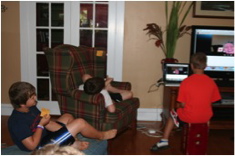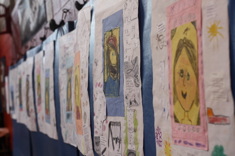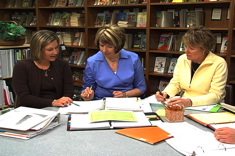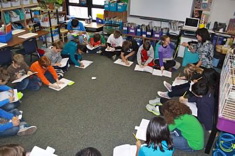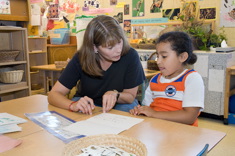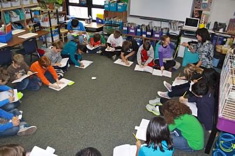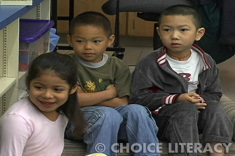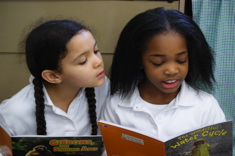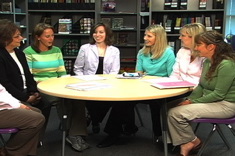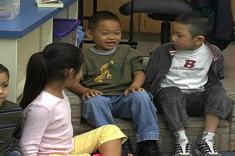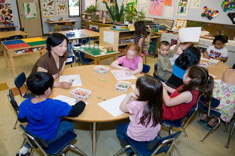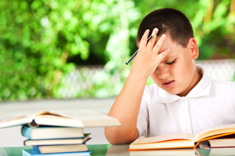Family Relations
Families come in many forms. A good rapport with parents, siblings, and grandparents can make all the difference in building a classroom and school community. Here are some creative suggestions for reaching out to families through conferences, special events, and volunteer opportunities. Our contributors also share the challenges of communicating with parents, and what they've learned when they've failed to connect.
Latest Content
One Book, One School: Building Community with Shared Text
"When given the choice between being right or being kind, choose kind." These words from the book Wonder set Katherine Sokolowski on the path of designing a shared reading experience at her school that will build community and empathy across the grades.
Don’t Be a Sneetch
Amanda Adrian ponders end-of-year celebrations, as well as the haves and have-nots, in schools.
An At-Home Summer Reading Camp
Katherine Sokolowski comes up with a novel way to boost kids’ reading and her summer income —hosting a reading camp in her home.
What to Say on Parent Teacher Night
Clare Landrigan and Tammy Mulligan present some of the anecdotes and research they would share with parents during open houses and conferences.
Using Video to Build the Home-School Connection
Video is a terrific tool for building connections between home and school. Heather Rader explains how Kelli Demonte uses video to guide children and communicate with families.
Conferring with Parents (ROUND-UP)
There is always a new tweak to consider with conferences involving families. Choice Literacy Contributors have both the head and heart in mind with these tips.
A Poetry Cafe Celebration
Stella Villalba explains how her poetry cafe program brings families together for a festive event, and helps English language learners develop reading and fluency skills at the same time. This is the first installment in a two-part series.
Tuesday Trading Post: Involving the Whole School in a Book Exchange
Here's a terrific idea for building the home/school reading connection and involving parent groups in literacy. Andrea Smith shares the nuts and bolts of the Tuesday Trading Post, a schoolwide book exchange.
Books, Books, Books
Parents of young children may be drawn to text tied to movies or other pop culture filler books. Trish Prentice shares a letter she sends home to families to encourage even the youngest learners to find books and authors with a little more staying power.
Spring Reading Interviews (TEMPLATE)
Kindergartners may be too young for reading interviews early in the fall, but Mandy Robek finds spring reading interviews are an excellent bridge to families and summer reading suggestions.
Tips from Literacy Leaders for Closing Out the School Year (ROUND-UP)
Here are some suggestions from Choice Literacy Contributors of the best ways to close out the year, with everything from personal organizing tips to family events.
Letting Go After Holding on Tight: Reflecting on the Last Days of School
Andrea Smith writes about how our instincts as parents and teachers merge to make it so hard to say goodbye at the end of the school year.
The Nuts and Bolts of the Family Inquiry Project
Julie Johnson explains how a family history inquiry project in her first-grade classroom builds technology, literacy, and research skills as students explored many cultures. This article is the second in a two-part series.
34 Languages
What is the starting point for building community in a preschool classroom where almost every child speaks a different first language than their teacher? Melissa Kolb writes about how she gently guides her preschool students early in the year.
Literacy Keepsakes to Carry Home at the End of the School Year
Choice Literacy readers share their favorite gifts for students to make and take home at the end of the year.
More Literacy Keepsakes to Carry Home at the End of the School Year
Choice Literacy readers share more of their favorite end-of-year gifts for students to make and take home.
Beginning with the End in Mind: Planning Ahead for Closing Activities
Choice Literacy readers share their favorite end-of-year activities that circle back to events from the start of the school year.
Getting to Know Multilingual Learners at the Start of the Year
If you’re unsure about working with multilingual learners, Stella Villalba has some reassuring advice for you.
Make it Personal
The connections we make with students and families are what we remember most when all is said and done. Trish Prentice has thoughts on what changes a respected teacher into a beloved teacher.
A Congenial Parent Night
Invigorate your parent night with these suggestions from Trish Prentice.
Parent Contributions Beyond Instructional Support
Parents want to contribute, but not all contributions are welcome or even helpful when it comes to teaching children how to read and write. Trish Prentice has suggestions for making the most of family skills and willingness to help.
“This Could Be Our Family”: Books for Children with Lesbian and Gay Parents
Andie Cunningham considers the diversity in how “families” are defined in children’s literature, as well as how some newer books can support children with lesbian or gay parents in our new booklist.
Sharing Data with Families at Parent/Teacher Conferences
How can teachers use assessment data in conferences with parents, without overwhelming them with information? Clare Landrigan and Tammy Mulligan recommend a "data snippets" approach.
How Do We Talk with Parents About What It Means to Be Challenged in Reading?
Discussions with parents of precocious young readers can be tricky. Clare Landrigan and Tammy Mulligan have some tips for these conferences.
Creating a Culture of Literacy
How do we create schools and communities where everyone is passionate about reading and writing? Shari Frost has practical advice for teachers and school leaders.
Bilingual (English/Spanish) Books that Celebrate Language, Family and Culture
Stella Villalba shares her favorite bilingual (English/Spanish) books for helping young English language learners feel at home in new classrooms early in the year.
Lessons from Family Writer’s Workshop
Clare Landrigan and Tammy Mulligan remind us that our own children are often our best teachers. Here they share all they learned from their children during a summer of writing together.
Talking with Parents about Text Difficulty
Clare Landrigan and Tammy Mulligan write about how to share the research base and goal of producing lifelong readers with families in understandable terms. The article includes a handout to share at parent meetings.
What Reading is Like: Sports Analogies to Use with Parents
Clare Landrigan and Tammy Mulligan provide some sports analogies to share with families when talking about reading growth. The article includes a handout of prompts parents can use to spark discussions about books with their children.
What My Son’s Reading Difficulties Taught Me About Teaching Struggling Readers
No matter how many education methods courses and professional development workshops you take, if you’re a parent, your children will always teach you the most about how students learn. Tammy Mulligan shares three practical strategies for reaching struggling readers that she learned from experiences with her son.
Browse Content By
Type
Category
- Assessment Tools
- Big Fresh Archives
- Booklists
- Choice Numeracy
- Classroom Design
- Common Core
- Community Building
- Conferring
- Content Literacy
- Digital Literacy
- English Language Learners
- Equity
- Family Relations
- Free Samples
- Guiding Groups
- Leadership
- Literacy Coaches
- Mentor Texts
- Minilessons
- New Teacher Mentors
- Podcasts
- Poetry
- Quote Collections
- Reading Strategies
- Self Care
- Struggling and Striving Learners
- Talking and Listening
- Teacher Study Groups
- Teaching Reading
- Teaching Writing
- Word Study and Vocabulary
Author
- Melissa Quimby
- Nawal Qarooni
- Gwen Blumberg
- Julie Cox
- The Lead Learners
- Hannah Tills
- Josie Stewart
- Ruth Metcalfe
- Mallory Messenger
- Becca Burk
- Jodie Bailey
- Vivian Chen
- Mary Brower
- Tiffany Abbott Fuller
- Stephanie Affinito
- Ruth Ayres
- Leigh Anne Eck
- Heather Fisher
- Shari Frost
- Julie Johnson
- Suzy Kaback
- Gigi McAllister
- Shirl McPhillips
- Melanie Meehan
- Cathy Mere
- Debbie Miller
- Tara Barnett and Kate Mills
- Tammy Mulligan
- Dana Murphy
- Bitsy Parks
- David Pittman
- Brenda Power
- Heather Rader
- Matt Renwick
- Mandy Robek
- Christy Rush-Levine
- Gretchen Schroeder
- Jen Schwanke
- Brian Sepe
- Katherine Sokolowski
- Stella Villalba
- Jennifer Vincent
Grade Level
Choice Literacy Membership
Articles
Get full access to all Choice Literacy article content
Videos
Get full access to all Choice Literacy video content
Courses
Access Choice Literacy course curriculum and training



